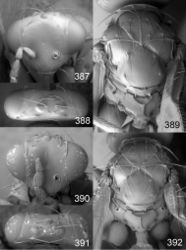Euplectrus hansoni
| Notice: | This page is derived from the original publication listed below, whose author(s) should always be credited. Further contributors may edit and improve the content of this page and, consequently, need to be credited as well (see page history). Any assessment of factual correctness requires a careful review of the original article as well as of subsequent contributions.
If you are uncertain whether your planned contribution is correct or not, we suggest that you use the associated discussion page instead of editing the page directly. This page should be cited as follows (rationale):
Citation formats to copy and paste
BibTeX: @article{Hansson2015ZooKeys, RIS/ Endnote: TY - JOUR Wikipedia/ Citizendium: <ref name="Hansson2015ZooKeys">{{Citation See also the citation download page at the journal. |
Ordo: Hymenoptera
Familia: Eulophidae
Genus: Euplectrus
Name
Euplectrus hansoni Schauff – Wikispecies link – Pensoft Profile
- Euplectrus hansoni Schauff in Schauff & Janzen, 2001: 203–204. Holotype ♀ (USNM), examined.
Material
Type material: ♀ holotype (USNM). Additional material: COSTA RICA: 1♀ from Guanacaste, ACG, Sector Pitilla, Sendero Mismo, 30.viii.2006, ex Isochromodes sheilaDHJ05 on Calatola costaricensis, caterpillar project voucher code 06-SRNP-34036, no barcode (BMNH).
Diagnosis
Lower face medially dark reddish-brown, pale area reaching to level of middle of toruli (Fig. 384); gaster with anterior ½ yellowish-brown with dark brown lateral margins, posterior ½ dark brown (Fig. 385); legs yellowish-brown (Fig. 383); occipital margin rounded (Fig. 391); petiole 1.2× as long as wide.
Description
Female. Length of body 2.6 mm. Antenna with scape, pedicel and flagellomere 1 yellowish-brown, 2 pale brown, 3–6 dark brown (Fig. 386). Mandibles yellowish-brown, palpi yellowish-white. Head black and shiny, lower face medially dark reddish-brown, pale area reaching to level of middle of toruli, with part between pale area and eyes black (Fig. 384). Frons close to eyes with two rows of setae (Fig. 390). Vertex smooth (Fig. 391). Occipital margin rounded (Fig. 391).
Mesosoma black and shiny (Fig. 383). Each sidelobe of mesoscutum with 13 setae. Scutellum 0.9× as long as wide; with very weak engraved reticulation (Fig. 392). Dorsellum with a very narrow groove along anterior margin (Fig. 790), medially less than 0.1× as long as length of dorsellum. Propodeum smooth (Fig. 790); anteromedially with a semicircular cup; propodeal callus with eight setae. Legs yellowish-brown (Fig. 383). Fore wing: costal cell with two complete rows of setae on ventral surface, and margin with nine setae in apical ½; with 35 admarginal setae, in two rows in basal ⅔, with three rows in apical ⅓.
Gaster with anterior ½ yellowish-brown with dark brown lateral margins, posterior ½ dark brown (Fig. 385).
Ratios. HE/MS/WM = 2.3/1.0/1.2; POL/OOL/POO = 8.4/5.0/1.0; OOL/DO = 0.9; WE/WF/WH/HH = 1.0/2.3/4.3/3.2; WH/WT = 1.1; PM/ST = 1.9; TS1/TS2/LT/LT1/LT2/LT3/LT4 = 4.7/2.9/7.8/2.7/1.6/1.0/2.0; LP/WP = 1.2; MM/LG = 0.9.
Male. Unknown.
Hosts and biology
Isochromodes sheilaDHJ05 (Geometridae) feeding on Calatola costaricensis (Icacinaceae) (new record).
Distribution
Costa Rica (Guanacaste Province) (Schauff and Janzen 2001[1]).
Taxon Treatment
- Hansson, C; Smith, M; Janzen, D; Hallwachs, W; 2015: Integrative taxonomy of New World Euplectrus Westwood (Hymenoptera, Eulophidae), with focus on 55 new species from Area de Conservación Guanacaste, northwestern Costa Rica ZooKeys, (485): 1-236. doi
Images
|
Other References
- ↑ Schauff M, Janzen D (2001) Taxonomy and ecology of Costa Rican Euplectrus (Hymenoptera: Eulophidae), parasitoids of caterpillars. Journal of Hymenoptera Research 10: 181–230.


